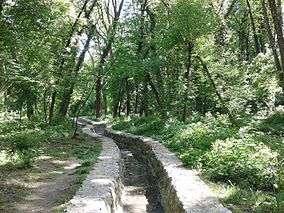Banjica forest
| Byford's Forest | |
|---|---|
|
(Serbian: Бајфордова шума Bajfordova šuma) | |
|
IUCN category III (natural monument or feature) | |
 Stream in the Byford's Forest | |
 Location within Belgrade | |
| Location |
Voždovac, Belgrade |
| Coordinates | 44°45′58″N 20°28′35″E / 44.7660°N 20.476468°ECoordinates: 44°45′58″N 20°28′35″E / 44.7660°N 20.476468°E |
| Area | 0.4 km2 (0.15 sq mi) |
| Established | 15 September 2015 |
Byford's Forest[1] (Serbian: Бајфордова шума, translit. Bajfordova šuma} is a forest in Belgrade, the capital of Serbia. It is located in the Belgrade's municipality of Voždovac and until 2015 was known as Banjica Forest (Serbian: Бањичка шума, translit. Banjička šuma}.
Location
Byford's Forest is a meridionally elongated wooded area between the Boulevard of the Liberation on the east and the street of Pavla Jurišića Šturma on the west. South and southeast border is marked by the Crnotravska street. It begins less than 4 km (2.5 mi) away from Terazije, downtown Belgrade. It borders the neighborhoods of Diplomatska Kolonija and Dedinje on the west, Banjica on the southwest and south, Trošarina on the southeast and Voždovac on the east. The forest is some 2 km (1.2 mi) long, up to 300 300 m (980 ft) wide and covers an area of 0.4 km2 (0.15 sq mi).
History
Before World War I there was a wood in this area, but was cut down to make room for the vegetable gardens. During the Interbellum, military command built workshops for the repair of the vehicles within the complex of the military auto motorized units of the Royal Yugoslav Army (Serbian: Autokomanda), which gave name to the neighboring square and the neighborhood. Prior to the World War II, shooting range was located here. In an effort to create the forested belt around the Belgrade, the forest, initially named Banjica Forest, was planted from 1948 to 1950[2] (for example, Šumice Forest was created as a part of the same project).
Wildlife
Plant life
Most common tree species are pedunculate oak, red maple, silver maple and box elder, but there are many others as well. There are numerous wildflowers on the forest floor, including wood avens, violets, strawberries, garlic mustard, deadnettles etc.
Animal life
Bird species are very diverse so because of them, Banjica forest is now a natural monument, protected by the state. 68 bird species live in the forest, 40 of which are resident birds, 16 are migratory birds and 12 are passing.[3] The most common breeding birds are nightingale, blackcap, great tit, European magpie, hooded crow, common blackbird, woodpigeon and great spotted woodpecker. Other bird species in the forest include pheasant, common kestrel, Eurasian sparrowhawk, tawny owl and common chaffinch. During the winter, hawks, common buzzards and song thrush also settle in the forest.[4]
Mammals include Eastern European hedgehog, moles, several species of shrews, various bats, the local brown subspecies of the red squirrel, wood mouse, yellow-necked mouse and least weasel. Altogether, there are 10 species of mammals in the forest, including hares which settled the forest in 2008.[5]
Features

The man-made facilities in the forest include the Lukoil gas station and the Best Western Hotel "M". The south-western extension of the forest was turned into the large sports complex of Banjica decades ago.
On the occasion of the April 22, 2007, the Earth Day, the city government announced its plans for the Banjica forest in 2007, which will include the construction of the trim trail, artificial bed for the forest's stream and placing of bird houses through the forest.[6]
As in the spring of 2011, the main forest path (going along the length of the forest) has a form of a functional trim trail, while the smaller paths are left in their natural state. Some old trees were cut and timber was cut in smaller pieces and left at the spot, attracting insects and insect-eating birds. Benches and wooden wastebaskets are placed periodically along the trim trail, while there are also several well-spaced spots with information tables and multiple benches under wooden roofs, intended for rest of several families. There are a wooden and a stone-based bridge over the widest parts of the stream, as well as several plank bridges over the narrowest parts. Bird houses are placed all over the forest.
Name change
Timothy John Byford, British director, author and educator, who lived in Serbia since 1971, studied birds in the forest, and from 1986 to 1989, collected data on all 68 species. He began an initiative to protect the forest. He died in 2014, before the forest was placed under protection. The Institute for Nature Conservation of Serbia and the Belgrade City Secretariat for Environmental Protection, after a public hearing, declared the forest a natural monument on 15 September 2015. Also, by the same act, the name of the forest was changed to the Byford's Forest.[1][7]
References
- 1 2 Tanjug (15 September 2015), "Banjička šuma je od danas "Bajfordova šuma"", N1 (in Serbian)
- ↑ Milan Janković (27 April 2014), "Beogradske šume preživele i ratove", Politika (in Serbian)
- ↑ Plate at forest's entrances
- ↑ A.V. (23 May 2017), "Ptice Bajfordove šume", Politika (in Serbian), p. 15
- ↑ Branka Vasiljević (November 2008), "Prestonica - dom za sisare", Politika (in Serbian)
- ↑ Politika daily, April 21, 2007
- ↑ Institute for Nature Conservation of Serbia - The public hearing on "Byford`s Forest"
External links
| Wikimedia Commons has media related to Banjica Forest. |